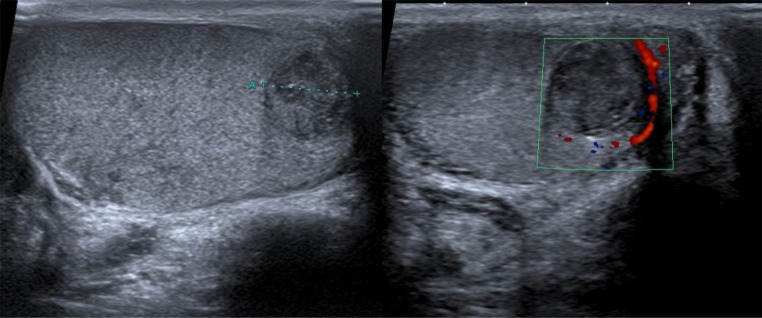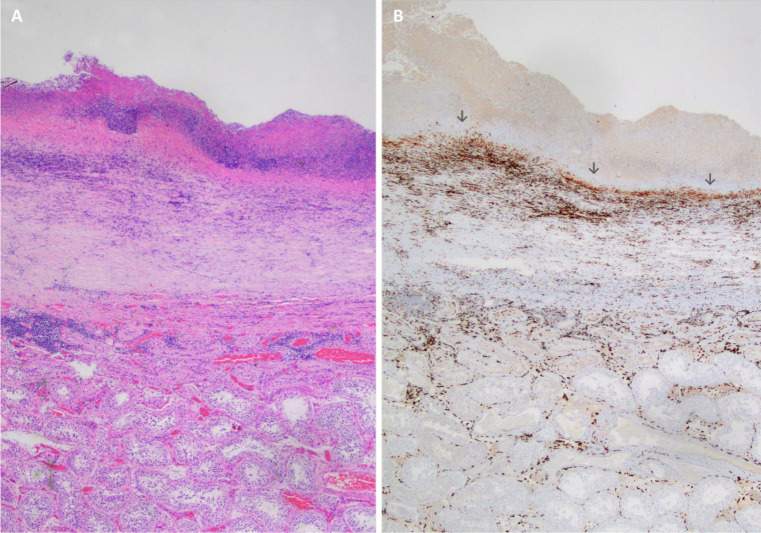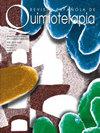D Fernández Vecilla, J Aragón Díez, M C Nieto Toboso, J Rosselló Soria, J L Díaz de Tuesta Del Arco
下载PDF
{"title":"慢性睾丸附睾肉芽肿是否与生殖支原体有关?病例报告及文献复习。","authors":"D Fernández Vecilla, J Aragón Díez, M C Nieto Toboso, J Rosselló Soria, J L Díaz de Tuesta Del Arco","doi":"10.37201/req/082.2022","DOIUrl":null,"url":null,"abstract":"Rev Esp Quimioter 2023;36(1): 103-106 103 to anatomic pathology for study and a 1.6 x 1.1 cm lesion of yellowish-white coloration and necrotic-purulent appearance was observed. Microscopically (Figure 2), a necrotizing, impaling and exudative granulomatous lesion was observed, while in the rest of the epididymis chronic inflammatory changes with suppurative flare-up and images of spermatogenic granuloma of long evolution were observed. Grocott, Ziehl and Warthin-Starry techniques (which can detect fungi, mycobacteria and Helicobacter pylori or spirochetes, respectively), together with immunohistochemical markers for germinal lesion (OCT-4 and SALL-4), as well as PLAP, D2-40 and CK AE1-AE3, were negative. DNA eluate was obtained using the Cobas© DNA Sample Preparation Kit panel (Roche Diagnostics, Basel, Switzerland) from the lesion to perform PCR of Mycobacterium tuberculosis using the GenoType Mycobacteria Direct panel (Hain Lifescience, Nehren, Germany), which allows us, by amplification of 23S rRNA, the detection of M. tuberculosis Complex, Mycobacterium avium, Mycobacterium intracellulare, Mycobacterium kansasii and Mycobacterium malamoense, with negative results. The STI Essential Assay AllpexTM panel (Seegene, Seoul, South Korea) that detects 7 pathogens related to sexually transmitted infections (Chlamydia trachomatis, Mycoplasma genitalium, Mycoplasma hominis, Neisseria gonorrhoeae, Trichomonas vaginalis, Ureaplasma parvum and Ureaplasma urealyticum) was also performed, detecting M. genitalium with Ct (cycle threshold) values of 21. A semen sample was sent 1 month after this study and the STI Essntial Assay Allplex© panel again detected M. genitalium, but this time with Ct values of 33. In addition, the ResistancePlus© MG FleXible panel was performed on the GeneXpert system (Cepheid, California, USA), which detects both M. genitalium and macrolide resistance mediated by mutations in the 23S rRNA gene, with detection of the microorganism, but without detection of the mutation.","PeriodicalId":21232,"journal":{"name":"Revista Espanola De Quimioterapia","volume":"36 1","pages":"103-106"},"PeriodicalIF":2.2000,"publicationDate":"2023-02-01","publicationTypes":"Journal Article","fieldsOfStudy":null,"isOpenAccess":false,"openAccessPdf":"https://ftp.ncbi.nlm.nih.gov/pub/pmc/oa_pdf/db/ff/revespquimioter-36-103.PMC9910672.pdf","citationCount":"0","resultStr":"{\"title\":\"Could Mycoplasma genitalium be involved in chronic granulomatous orchiepididymits? Case report and literature review.\",\"authors\":\"D Fernández Vecilla, J Aragón Díez, M C Nieto Toboso, J Rosselló Soria, J L Díaz de Tuesta Del Arco\",\"doi\":\"10.37201/req/082.2022\",\"DOIUrl\":null,\"url\":null,\"abstract\":\"Rev Esp Quimioter 2023;36(1): 103-106 103 to anatomic pathology for study and a 1.6 x 1.1 cm lesion of yellowish-white coloration and necrotic-purulent appearance was observed. Microscopically (Figure 2), a necrotizing, impaling and exudative granulomatous lesion was observed, while in the rest of the epididymis chronic inflammatory changes with suppurative flare-up and images of spermatogenic granuloma of long evolution were observed. Grocott, Ziehl and Warthin-Starry techniques (which can detect fungi, mycobacteria and Helicobacter pylori or spirochetes, respectively), together with immunohistochemical markers for germinal lesion (OCT-4 and SALL-4), as well as PLAP, D2-40 and CK AE1-AE3, were negative. DNA eluate was obtained using the Cobas© DNA Sample Preparation Kit panel (Roche Diagnostics, Basel, Switzerland) from the lesion to perform PCR of Mycobacterium tuberculosis using the GenoType Mycobacteria Direct panel (Hain Lifescience, Nehren, Germany), which allows us, by amplification of 23S rRNA, the detection of M. tuberculosis Complex, Mycobacterium avium, Mycobacterium intracellulare, Mycobacterium kansasii and Mycobacterium malamoense, with negative results. The STI Essential Assay AllpexTM panel (Seegene, Seoul, South Korea) that detects 7 pathogens related to sexually transmitted infections (Chlamydia trachomatis, Mycoplasma genitalium, Mycoplasma hominis, Neisseria gonorrhoeae, Trichomonas vaginalis, Ureaplasma parvum and Ureaplasma urealyticum) was also performed, detecting M. genitalium with Ct (cycle threshold) values of 21. A semen sample was sent 1 month after this study and the STI Essntial Assay Allplex© panel again detected M. genitalium, but this time with Ct values of 33. In addition, the ResistancePlus© MG FleXible panel was performed on the GeneXpert system (Cepheid, California, USA), which detects both M. genitalium and macrolide resistance mediated by mutations in the 23S rRNA gene, with detection of the microorganism, but without detection of the mutation.\",\"PeriodicalId\":21232,\"journal\":{\"name\":\"Revista Espanola De Quimioterapia\",\"volume\":\"36 1\",\"pages\":\"103-106\"},\"PeriodicalIF\":2.2000,\"publicationDate\":\"2023-02-01\",\"publicationTypes\":\"Journal Article\",\"fieldsOfStudy\":null,\"isOpenAccess\":false,\"openAccessPdf\":\"https://ftp.ncbi.nlm.nih.gov/pub/pmc/oa_pdf/db/ff/revespquimioter-36-103.PMC9910672.pdf\",\"citationCount\":\"0\",\"resultStr\":null,\"platform\":\"Semanticscholar\",\"paperid\":null,\"PeriodicalName\":\"Revista Espanola De Quimioterapia\",\"FirstCategoryId\":\"3\",\"ListUrlMain\":\"https://doi.org/10.37201/req/082.2022\",\"RegionNum\":4,\"RegionCategory\":\"医学\",\"ArticlePicture\":[],\"TitleCN\":null,\"AbstractTextCN\":null,\"PMCID\":null,\"EPubDate\":\"\",\"PubModel\":\"\",\"JCR\":\"Q4\",\"JCRName\":\"MICROBIOLOGY\",\"Score\":null,\"Total\":0}","platform":"Semanticscholar","paperid":null,"PeriodicalName":"Revista Espanola De Quimioterapia","FirstCategoryId":"3","ListUrlMain":"https://doi.org/10.37201/req/082.2022","RegionNum":4,"RegionCategory":"医学","ArticlePicture":[],"TitleCN":null,"AbstractTextCN":null,"PMCID":null,"EPubDate":"","PubModel":"","JCR":"Q4","JCRName":"MICROBIOLOGY","Score":null,"Total":0}
引用次数: 0
引用
批量引用
Could Mycoplasma genitalium be involved in chronic granulomatous orchiepididymits? Case report and literature review.
Rev Esp Quimioter 2023;36(1): 103-106 103 to anatomic pathology for study and a 1.6 x 1.1 cm lesion of yellowish-white coloration and necrotic-purulent appearance was observed. Microscopically (Figure 2), a necrotizing, impaling and exudative granulomatous lesion was observed, while in the rest of the epididymis chronic inflammatory changes with suppurative flare-up and images of spermatogenic granuloma of long evolution were observed. Grocott, Ziehl and Warthin-Starry techniques (which can detect fungi, mycobacteria and Helicobacter pylori or spirochetes, respectively), together with immunohistochemical markers for germinal lesion (OCT-4 and SALL-4), as well as PLAP, D2-40 and CK AE1-AE3, were negative. DNA eluate was obtained using the Cobas© DNA Sample Preparation Kit panel (Roche Diagnostics, Basel, Switzerland) from the lesion to perform PCR of Mycobacterium tuberculosis using the GenoType Mycobacteria Direct panel (Hain Lifescience, Nehren, Germany), which allows us, by amplification of 23S rRNA, the detection of M. tuberculosis Complex, Mycobacterium avium, Mycobacterium intracellulare, Mycobacterium kansasii and Mycobacterium malamoense, with negative results. The STI Essential Assay AllpexTM panel (Seegene, Seoul, South Korea) that detects 7 pathogens related to sexually transmitted infections (Chlamydia trachomatis, Mycoplasma genitalium, Mycoplasma hominis, Neisseria gonorrhoeae, Trichomonas vaginalis, Ureaplasma parvum and Ureaplasma urealyticum) was also performed, detecting M. genitalium with Ct (cycle threshold) values of 21. A semen sample was sent 1 month after this study and the STI Essntial Assay Allplex© panel again detected M. genitalium, but this time with Ct values of 33. In addition, the ResistancePlus© MG FleXible panel was performed on the GeneXpert system (Cepheid, California, USA), which detects both M. genitalium and macrolide resistance mediated by mutations in the 23S rRNA gene, with detection of the microorganism, but without detection of the mutation.



 求助内容:
求助内容: 应助结果提醒方式:
应助结果提醒方式:


